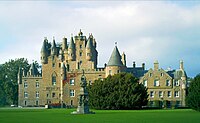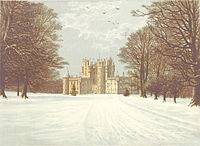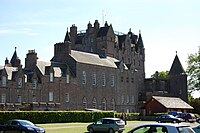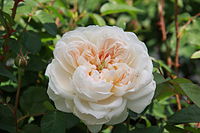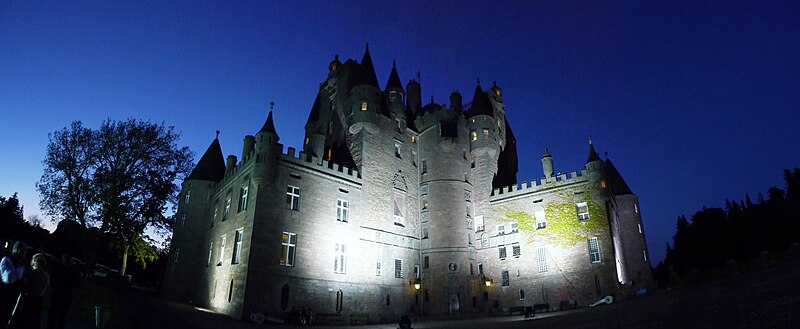Difference between revisions of "Glamis Castle"
(Created page with "{{Infobox castle |name=Glamis Castle |village=Glamis |county=Angus |picture=GlamisWide.JPG |picture caption=Glamis Castle |latitude=56.6203 |longitude=-3.0024 |type= |builder=...") |
(No difference)
|
Latest revision as of 19:59, 18 September 2014
| Glamis Castle | |
|
Angus | |
|---|---|
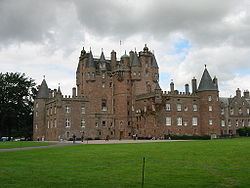 Glamis Castle | |
| Location | |
| Location: | 56°37’13"N, 3°0’9"W |
| Village: | Glamis |
| History | |
| Information | |
| Condition: | Preserved |
| Owned by: | The Earl of Strathmore and Kinghorne |
Glamis Castle is a castle serving as a grand house and the home of the Earl and Countess of Strathmore and Kinghorne. It stands grand house beside the village of Glamis in Angus. It is opened to the public.
Glamis Castle has been the home of the Lyon family since the 14th century, though the present building dates largely from the 17th century. Glamis was the childhood home of Queen Elizabeth The Queen Mother, wife of King George VI. Their second daughter, Princess Margaret, Countess of Snowdon, was born there.
The castle is protected as a Category A listed building,[1] and the grounds are included on the Inventory of Gardens and Designed Landscapes in Scotland.[2]
Contents
Setting
Glamis is set in the broad and fertile lowland valley of Strathmore, near Forfar, the county town, which lies between the Sidlaw Hills to the south and the Grampian Mountains to the north, approximately 12 miles inland from the North Sea. The estate surrounding the castle covers more than 14,085 acres and, in addition to parks and gardens, produces several cash crops including timber and beef. There are two streams running through the estate, one of them the Glamis Burn. An arboretum overlooking Glamis Burn features trees from all over the world, many of them rare and several hundred years old. Birds and other small wildlife are common throughout the grounds.
History
The vicinity of Glamis Castle has prehistoric traces; for example, a noted intricately carved Pictish stone known as the Eassie Stone was found in a creek-bed at the nearby village of Eassie.[3]
In 1034, King Malcolm II was murdered at Glamis,[4] where there was a Royal Hunting Lodge.[5] In William Shakespeare's play Macbeth (1603–06), the eponymous character resides at Glamis Castle and is titled "Thane of Glamis", though the historical King Macbeth (who was slain in 1057) had no connection to the castle nor the title, though the title "Thane of Glamis" is authentic.
By 1376 a castle had been built at Glamis, since in that year it was granted by King Robert II to Sir John Lyon, Thane of Glamis, husband of the king's daughter. Glamis has remained in the Lyon (later Bowes-Lyon) family since this time. The castle was rebuilt as an L-plan tower house in the early 15th century.[6]
The title Lord Glamis was created in 1445 for Sir Patrick Lyon (1402–1459), grandson of Sir John. The 15th-century "Earl Beardie" of legend has been identified with both Alexander Lyon, 2nd Lord Glamis (died 1486),[7] and with Alexander Lindsay, 4th Earl of Crawford (died 1453).[8]
John Lyon, 6th Lord Glamis, married Janet Douglas, daughter of the Master of Angus, at a time when King James V was feuding with the Douglases. In December 1528 Janet was accused of treason for bringing supporters of the Earl of Angus to Edinburgh. She was then charged with poisoning her husband, Lord Glamis, who had died on 17 September 1528. Eventually, she was accused of witchcraft, and was burned at the stake at Edinburgh on 17 July 1537. James V subsequently seized Glamis, living there for some time.[5]
In 1543 Glamis was returned to John Lyon, 7th Lord Glamis. In 1606, Patrick Lyon, 9th Lord Glamis, was created Earl of Kinghorne. He began major works on the castle, commemorated by the inscription "Built by Patrick, Lord Glamis, and D[ame] Anna Murray" on the central tower.[1] The architect Inigo Jones has traditionally been linked to the redesign of the castle, though Historic Scotland consider the King's Master Mason William Schaw a more likely candidate, due to the traditional Scottish style of the architecture.[1]
During Cromwell's 'Commonwealth of England, Scotland and Ireland', soldiers were garrisoned at Glamis. In 1670, Patrick Lyon, 3rd Earl of Strathmore and Kinghorne, returned to the castle and found it uninhabitable. Restorations took place until 1689, including the creation of a major Baroque garden.[1][5] John Lyon, 9th Earl of Strathmore and Kinghorne, succeeded in 1753, and in 1767 he married Mary Eleanor Bowes, heiress to a coal-mining fortune. He set about improving the grounds of the castle in the picturesque style in the 1770s.[1] The south-west wing was rebuilt after a fire in the early 19th century. In the 1920s a huge fireplace from Gibside, the Bowes-Lyon estate near Wakefield, was removed and placed in Glamis' Billiard Room. The fireplace displays the coat of arms of the Blakiston family; Gibside heiress Elizabeth Blakiston had married Sir William Bowes.[6][9] Several interiors, including the Dining Room, also date from the 18th and 19th centuries.[1]
In 1900, Lady Elizabeth Bowes-Lyon was born, youngest daughter of Claude Bowes-Lyon, 14th Earl of Strathmore and Kinghorne and his countess, Cecilia. She spent much of her childhood at Glamis. During the First World War the castle was used as a military hospital,[1] and Lady Elizabeth was particularly instrumental in organising the rescue of the castle's contents during a serious fire on 16 September 1916.[10]
On 26 April 1923, Elizabeth Bowes-Lyon married Prince Albert, Duke of York, second son of King George V, at Westminster Abbey. Their second daughter, Princess Margaret, was born at Glamis Castle in 1930.[1]
Since 1987 an illustration of the castle has featured on the reverse side of ten pound notes issued by the Royal Bank of Scotland.[11]
Glamis is currently the home of Michael Bowes-Lyon, 18th Earl of Strathmore and Kinghorne, a former army officer, who succeeded to the earldom in 1987.
Legends and tales
Earl Beardie
Of the legend of Earl Beardie, several versions exist, and 'Earl Beardie' has been identified with both Alexander Lyon, 2nd Lord Glamis[7] and Alexander Lindsay, 4th Earl of Crawford.[8] The tale tells that Earl Beardie was playing cards on the sabbath, and either his hosts refused to play, or a servant advised him to stop. Lord Beardie became so furious that he asserted that he would play until domesday, or with the Devil himself, depending on the version. A stranger then appears at the castle and joins Lord Beardie in a game of cards. The stranger is identified with the Devil, who takes Earl Beardie's soul and, in some versions, condemns the Earl to play cards until domesday.[12]
The Monster of Glamis
The most famous legend connected with the castle is that of the Monster of Glamis, a hideously deformed child born to the family. Some accounts came from singer and composer Virginia Gabriel who stayed at the castle in 1870.[13] In the story, the monster was kept in the castle all his life and his suite of rooms bricked up after his death.[7][14][15][16]
An alternative version of the legend is that to every generation of the family a vampire child is born and is walled up in that room.[14]
There is an old story that guests staying at Glamis once hung towels from the windows of every room in a bid to find the bricked-up suite of the monster. When they looked at it from outside, several windows were apparently towel-less.[14]
The legend of the monster may have been inspired by the true story of the Ogilvies.[14][17][18] Somewhere in the 16.0 feet (4.9 m) walls is the famous room of skulls, where the Ogilvie family, who sought protection from their enemies the Lindsays, were walled up to die of starvation.
Another monster is supposed to have dwelt in Loch Calder near the castle.
Other traditions
According to the official website for Glamis Castle, in 1034, King Malcolm II was mortally wounded in a nearby battle and taken to a Royal Hunting Lodge, which sat at the site of the present castle, where he died.
Description
The towers in front of the castle each measure 23 feet in diameter and are about 13 feet high, each having a modern parapet. The walls are 3.3 feet (1.0 m) thick.[6]
There is a small chapel within the castle with seating for 46 people. The story given to visitors by castle tour guides states that one seat in the chapel is always reserved for the "Grey Lady" (supposedly a ghost which inhabits the castle), thought to be Janet Douglas, Lady Glamis. According to the guides, the chapel is still used regularly for family functions, but no one is allowed to sit in that seat.[19]
Archives
The clock tower houses the castle's archives which include a wide range of historical material relating to the castle and the Bowes and Lyon families. These include a papal bull and the memoirs of Mary Eleanor Bowes. The current archivist is Ingrid Thomson. The Glamis archives have a close connection with the archives at the University of Dundee, and researchers who wish to consult material held in the Glamis Castle Archive do so in the search room at the University.[20]
Outside links
| ("Wikimedia Commons" has material about Glamis Castle) |
- Glamis Castle
- Ghosts and Hauntings in Glamis Castle, Mysterious Britain
References
- ↑ 1.0 1.1 1.2 1.3 1.4 1.5 1.6 1.7 "Glamis Castle: Listed Building Report". Historic Scotland. http://hsewsf.sedsh.gov.uk/pls/htmldb/f?p=2200:15:0::::BUILDING,HL:11701,glamis. Retrieved 22 February 2014.
- ↑ "Glamis Castle". Inventory of Gardens and Designed Landscapes in Scotland. Historic Scotland. http://data.historic-scotland.gov.uk/pls/htmldb/f?p=2400:15:0::::GARDEN:GDL00189. Retrieved 26 August 2011.
- ↑ Hogan, C. Michael (7 October 2007). "Eassie Stone". in Burnham, Andy. The Megalithic Portal. http://www.megalithic.co.uk/article.php?sid=17730.
- ↑ Black's Picturesque Tourist of Scotland. Adam and Charles Black. 1861.
- ↑ 5.0 5.1 5.2 "Glamis Castle: Site History". Inventory of Gardens and Designed Landscapes in Scotland. Historic Scotland. http://data.historic-scotland.gov.uk/pls/htmldb/f?p=2400:15:0::::GARDEN:GDL00189#history. Retrieved 26 August 2011.
- ↑ 6.0 6.1 6.2 "Glamis Castle, Site Number NO34NE 1.00". CANMORE. Royal Commission on the Ancient and Historical Monuments of Scotland. http://canmore.rcahms.gov.uk/en/site/32055/details/glamis+castle/. Retrieved 2011-08-26.
- ↑ 7.0 7.1 7.2 "Glamis Castle". Haunted Castles and Hotels. http://www.hauntedcastlesandhotels.com/Scotland/glamis.htm. Retrieved 9 September 2010.
- ↑ 8.0 8.1 Ash, Russell (2009). Top Ten of Britain. Hamlyn Publishing. p. 184.
- ↑ Heritage, Camelot. "Glamis Castle: The Billiard Room". British Heritage and Castles. Camelot Heritage. http://www.camelotintl.com/heritage/castles/scotland/glamis/glbilard.html. Retrieved September 12, 2010.
- ↑ William Shawcross (2009), Queen Elizabeth The Queen Mother: The Official Biography, Macmillan, pp. 79–80, ISBN 978-1-4050-4859-0
- ↑ "Current Banknotes : Royal Bank of Scotland". The Committee of Scottish Clearing Bankers. http://www.scotbanks.org.uk/banknotes_current_royal_bank_of_scotland.php. Retrieved 2008-10-17.
- ↑ Shand, William (24 September 2007). "Earl Beardie - the ghostly Earl of Crawford". Dundee Messenger. http://www.dundeemessenger.co.uk/myths/ghosts/earl_beardie.htm. Retrieved 2009-08-19.
- ↑ Dash, Mike (10 February 2012), The Monster of Glamis, Smithsonian, http://www.smithsonianmag.com/history/the-monster-of-glamis-92015626/?no-ist, retrieved 14 May 2014
- ↑ 14.0 14.1 14.2 14.3 Dash, Mike. The Monster of Glamis , CFI Blogs, June 9, 2009. Accessed September 8, 2010.
- ↑ The Crawford Papers: The Journals of David Lindsay, Twenty-Seventh Earl of Crawford during the years 1892–1940 (1984) Manchester University Press pp. 86–87
- ↑ Wentworth-Day, James (1967). The Queen Mother's Family Story. pp. 133–136.
- ↑ T.F. Thistleton Dyer (1900) Strange Pages From Family Papers, pp. 98–103
- ↑ Chambers's Journal 1898, pp. 627–28
- ↑ "Myths and Legends"
- ↑ "Treasures of Glamis Castle". Archives, Records and Artefacts at the University of Dundee. http://www.archives-records-artefacts.com/2011/04/treasures-of-glamis-castle.html. Retrieved 17 January 2012.
